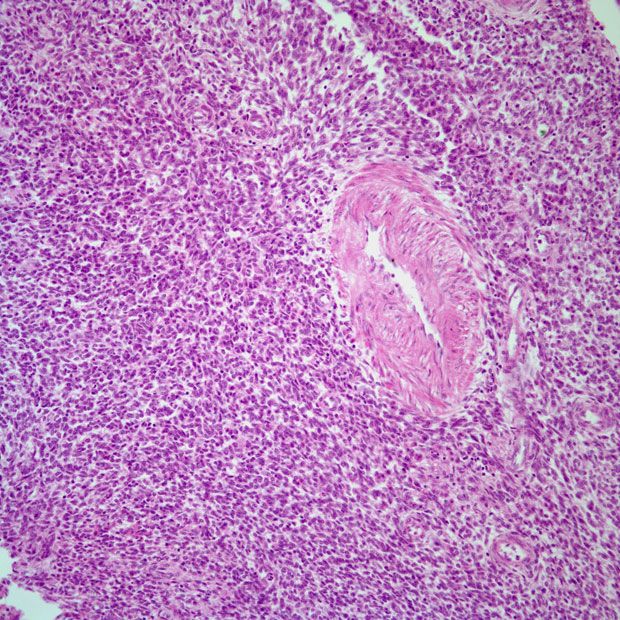Olaparib Plus Selumetinib Show Benefit in RAS-Mutated Ovarian and Endometrial Cancers
In the SOLAR phase 1b trial, a clinical benefit was observed when patients with RAS-mutated ovarian or endometrial cancer were given olaparib plus selumetinib.
Patients with RAS-mutated ovarian or endometrial cancer benefitted most from the recommended phase 2 dose of olaparib (Lynparza) plus selumetinib, according to results from the phase 1b dose expansion of the SOLAR trial (NCT05554328), which was presented at The Society of Gynecologic Oncology (SGO) 2023 Annual Meeting on Women’s Cancer.
"There was a 77% [rate of] clinical benefit, and a 44% objective response [rate]. We did see responders in histologies such as clear cell and endometrioid, so that was very exciting,” according to an expert from The University of Texas MD Anderson Cancer Center.

The recommended phase 2 dose was determined to be 300 mg of oral olaparib daily and 75 mg of oral selumetinib daily. For patients with RAS aberrant ovarian cancer, 69% of patients achieved a clinical benefit, with 32% having a partial response (PR), and 37% having standard disease after 4 or more cycles.
“We were interested to see if this response was driven mainly by low-grade serous [ovarian cancer]. There was a 77% [rate of] clinical benefit, and a 44% objective response [rate]. We did see responders in histologies such as clear cell and endometrioid, so that was very exciting,” Shannon N. Westin, MD, MPH, FACOG, professor in the Department of Gynecologic Oncology and Reproductive Medicine, Division of Surgery at The University of Texas MD Anderson Cancer Center, during the presentation, of which she was the principal investigator.
For those with RAS aberrant endometrial cancer, 59% had a clinical benefit, 35% experienced a PR, and 24% had stable disease after 4 or more cycles. Of note, the patients who had a PR, 2 had a BRCA mutation.
A total of 88 patients were analyzed, with a median age of 60.5 years old, and 77.3% of patients were female. The median lines of prior therapy were 3. A majority of patients were White, and 86.4% were non-Hispanic/Latinx.
Molecular aberrations were investigated and included 73 patients who had a RAS pathway mutation and 15 who had a BRCA mutation. There were 6 patients who had overlapping RAS and BRCA2 mutations. These included 3 patients with endometrial cancer and 3 patients with pancreatic cancer.
Overall, the most common grade 3/4 adverse effects (AEs) observed included anemia (12%), fatigue (5%), acneiform rash (5%), neutropenia (5%), and decreased white blood cell count (4%). Of note, there were no grade 4 AEs observed.
In patients with RAS aberrant ovarian cancer, dose interruptions were experienced in 49% of patients who had both drugs withheld, 5% withheld selumetinib, and 6% withheld olaparib. Additionally, dose reductions occurred in 13% of patients who withheld both drugs, 8% who withheld selumetinib, and 14% who withheld olaparib. Treatment discontinuation occurred in 7.9% of patients.
Across all patients, efficacy included 47% of patients who had a clinical benefit; 21% had a PR, with 3% experiencing it during dose escalation and 19% during dose expansion. In 26% of patients, stable disease occurred, with 3% of patients experiencing it during dose escalation, and 23% in dose expansion.
The study also looked at patients who had RAS aberrant tumors and included pancreatic, lung, appendiceal, cholangiocarcinoma, colon, and rectal. Of 36 patients treated, 26 were evaluable. Overall, 31% experienced a clinical benefit, with 8% having a PR, both of whom had lung cancer, and 19% had stable disease after 4 or more cycles.
“The majority of patients had KRAS mutations. The majority of BRCA mutations were observed in ovarian, colon, endometrial, and pancreatic cancer,” said Westin.
In patients who had PARP-resistant ovarian cancer, 15 patients were treated, and 12 were evaluable. A clinical benefit was observed in 41% of patients, 17% had a PR, both of whom had a BRCA mutation, and 25% had stable disease after 4 or more cycles.
Reference
Westin SN, Kurnit KC, Fellman B, et al. SOLAR: Phase Ib dose expansion of selumetinib (MEK Inhibitor) and OLAparib (PARP Inhibitor) combination in solid tumors with RAS pathway alterations and in PARP inhibitor-resistant ovarian cancer. Presented at: 2023 Annual Meeting on Women’s Cancer; March 25-28; Tampa, Florida.